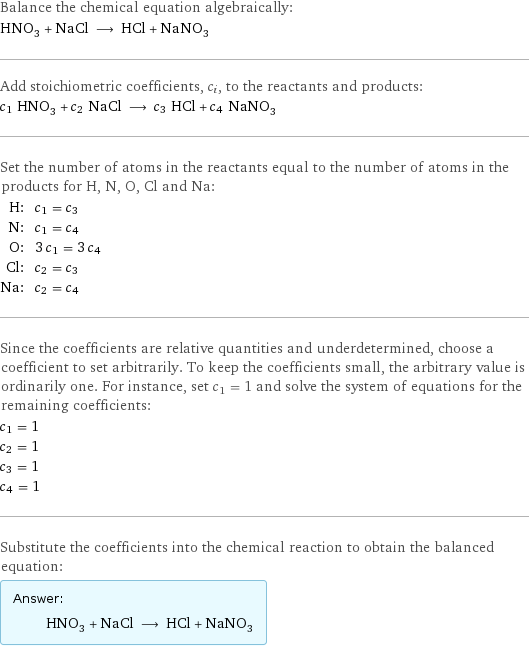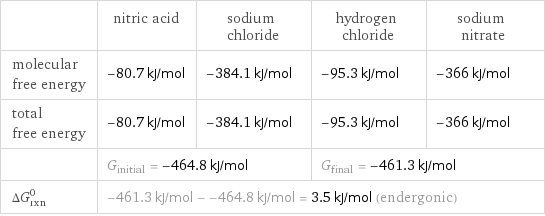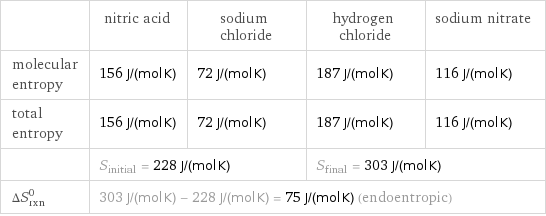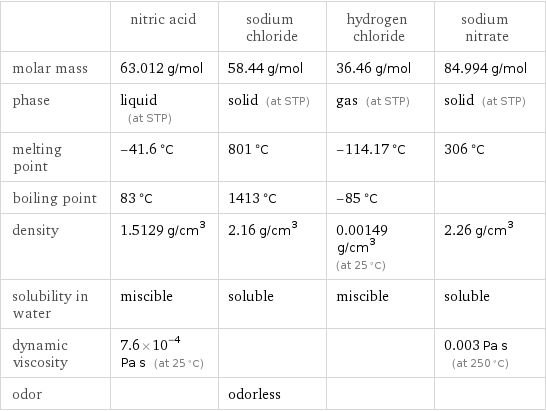Input interpretation

HNO_3 (nitric acid) + NaCl (sodium chloride) ⟶ HCl (hydrogen chloride) + NaNO_3 (sodium nitrate)
Balanced equation

Balance the chemical equation algebraically: HNO_3 + NaCl ⟶ HCl + NaNO_3 Add stoichiometric coefficients, c_i, to the reactants and products: c_1 HNO_3 + c_2 NaCl ⟶ c_3 HCl + c_4 NaNO_3 Set the number of atoms in the reactants equal to the number of atoms in the products for H, N, O, Cl and Na: H: | c_1 = c_3 N: | c_1 = c_4 O: | 3 c_1 = 3 c_4 Cl: | c_2 = c_3 Na: | c_2 = c_4 Since the coefficients are relative quantities and underdetermined, choose a coefficient to set arbitrarily. To keep the coefficients small, the arbitrary value is ordinarily one. For instance, set c_1 = 1 and solve the system of equations for the remaining coefficients: c_1 = 1 c_2 = 1 c_3 = 1 c_4 = 1 Substitute the coefficients into the chemical reaction to obtain the balanced equation: Answer: | | HNO_3 + NaCl ⟶ HCl + NaNO_3
Structures

+ ⟶ +
Names

nitric acid + sodium chloride ⟶ hydrogen chloride + sodium nitrate
Reaction thermodynamics
Gibbs free energy

| nitric acid | sodium chloride | hydrogen chloride | sodium nitrate molecular free energy | -80.7 kJ/mol | -384.1 kJ/mol | -95.3 kJ/mol | -366 kJ/mol total free energy | -80.7 kJ/mol | -384.1 kJ/mol | -95.3 kJ/mol | -366 kJ/mol | G_initial = -464.8 kJ/mol | | G_final = -461.3 kJ/mol | ΔG_rxn^0 | -461.3 kJ/mol - -464.8 kJ/mol = 3.5 kJ/mol (endergonic) | | |
Entropy

| nitric acid | sodium chloride | hydrogen chloride | sodium nitrate molecular entropy | 156 J/(mol K) | 72 J/(mol K) | 187 J/(mol K) | 116 J/(mol K) total entropy | 156 J/(mol K) | 72 J/(mol K) | 187 J/(mol K) | 116 J/(mol K) | S_initial = 228 J/(mol K) | | S_final = 303 J/(mol K) | ΔS_rxn^0 | 303 J/(mol K) - 228 J/(mol K) = 75 J/(mol K) (endoentropic) | | |
Equilibrium constant
![Construct the equilibrium constant, K, expression for: HNO_3 + NaCl ⟶ HCl + NaNO_3 Plan: • Balance the chemical equation. • Determine the stoichiometric numbers. • Assemble the activity expression for each chemical species. • Use the activity expressions to build the equilibrium constant expression. Write the balanced chemical equation: HNO_3 + NaCl ⟶ HCl + NaNO_3 Assign stoichiometric numbers, ν_i, using the stoichiometric coefficients, c_i, from the balanced chemical equation in the following manner: ν_i = -c_i for reactants and ν_i = c_i for products: chemical species | c_i | ν_i HNO_3 | 1 | -1 NaCl | 1 | -1 HCl | 1 | 1 NaNO_3 | 1 | 1 Assemble the activity expressions accounting for the state of matter and ν_i: chemical species | c_i | ν_i | activity expression HNO_3 | 1 | -1 | ([HNO3])^(-1) NaCl | 1 | -1 | ([NaCl])^(-1) HCl | 1 | 1 | [HCl] NaNO_3 | 1 | 1 | [NaNO3] The equilibrium constant symbol in the concentration basis is: K_c Mulitply the activity expressions to arrive at the K_c expression: Answer: | | K_c = ([HNO3])^(-1) ([NaCl])^(-1) [HCl] [NaNO3] = ([HCl] [NaNO3])/([HNO3] [NaCl])](../image_source/860b44bc91fd63e304d209f4cf08d0e2.png)
Construct the equilibrium constant, K, expression for: HNO_3 + NaCl ⟶ HCl + NaNO_3 Plan: • Balance the chemical equation. • Determine the stoichiometric numbers. • Assemble the activity expression for each chemical species. • Use the activity expressions to build the equilibrium constant expression. Write the balanced chemical equation: HNO_3 + NaCl ⟶ HCl + NaNO_3 Assign stoichiometric numbers, ν_i, using the stoichiometric coefficients, c_i, from the balanced chemical equation in the following manner: ν_i = -c_i for reactants and ν_i = c_i for products: chemical species | c_i | ν_i HNO_3 | 1 | -1 NaCl | 1 | -1 HCl | 1 | 1 NaNO_3 | 1 | 1 Assemble the activity expressions accounting for the state of matter and ν_i: chemical species | c_i | ν_i | activity expression HNO_3 | 1 | -1 | ([HNO3])^(-1) NaCl | 1 | -1 | ([NaCl])^(-1) HCl | 1 | 1 | [HCl] NaNO_3 | 1 | 1 | [NaNO3] The equilibrium constant symbol in the concentration basis is: K_c Mulitply the activity expressions to arrive at the K_c expression: Answer: | | K_c = ([HNO3])^(-1) ([NaCl])^(-1) [HCl] [NaNO3] = ([HCl] [NaNO3])/([HNO3] [NaCl])
Rate of reaction
![Construct the rate of reaction expression for: HNO_3 + NaCl ⟶ HCl + NaNO_3 Plan: • Balance the chemical equation. • Determine the stoichiometric numbers. • Assemble the rate term for each chemical species. • Write the rate of reaction expression. Write the balanced chemical equation: HNO_3 + NaCl ⟶ HCl + NaNO_3 Assign stoichiometric numbers, ν_i, using the stoichiometric coefficients, c_i, from the balanced chemical equation in the following manner: ν_i = -c_i for reactants and ν_i = c_i for products: chemical species | c_i | ν_i HNO_3 | 1 | -1 NaCl | 1 | -1 HCl | 1 | 1 NaNO_3 | 1 | 1 The rate term for each chemical species, B_i, is 1/ν_i(Δ[B_i])/(Δt) where [B_i] is the amount concentration and t is time: chemical species | c_i | ν_i | rate term HNO_3 | 1 | -1 | -(Δ[HNO3])/(Δt) NaCl | 1 | -1 | -(Δ[NaCl])/(Δt) HCl | 1 | 1 | (Δ[HCl])/(Δt) NaNO_3 | 1 | 1 | (Δ[NaNO3])/(Δt) (for infinitesimal rate of change, replace Δ with d) Set the rate terms equal to each other to arrive at the rate expression: Answer: | | rate = -(Δ[HNO3])/(Δt) = -(Δ[NaCl])/(Δt) = (Δ[HCl])/(Δt) = (Δ[NaNO3])/(Δt) (assuming constant volume and no accumulation of intermediates or side products)](../image_source/ba609c69c28ab769fc5262684404751d.png)
Construct the rate of reaction expression for: HNO_3 + NaCl ⟶ HCl + NaNO_3 Plan: • Balance the chemical equation. • Determine the stoichiometric numbers. • Assemble the rate term for each chemical species. • Write the rate of reaction expression. Write the balanced chemical equation: HNO_3 + NaCl ⟶ HCl + NaNO_3 Assign stoichiometric numbers, ν_i, using the stoichiometric coefficients, c_i, from the balanced chemical equation in the following manner: ν_i = -c_i for reactants and ν_i = c_i for products: chemical species | c_i | ν_i HNO_3 | 1 | -1 NaCl | 1 | -1 HCl | 1 | 1 NaNO_3 | 1 | 1 The rate term for each chemical species, B_i, is 1/ν_i(Δ[B_i])/(Δt) where [B_i] is the amount concentration and t is time: chemical species | c_i | ν_i | rate term HNO_3 | 1 | -1 | -(Δ[HNO3])/(Δt) NaCl | 1 | -1 | -(Δ[NaCl])/(Δt) HCl | 1 | 1 | (Δ[HCl])/(Δt) NaNO_3 | 1 | 1 | (Δ[NaNO3])/(Δt) (for infinitesimal rate of change, replace Δ with d) Set the rate terms equal to each other to arrive at the rate expression: Answer: | | rate = -(Δ[HNO3])/(Δt) = -(Δ[NaCl])/(Δt) = (Δ[HCl])/(Δt) = (Δ[NaNO3])/(Δt) (assuming constant volume and no accumulation of intermediates or side products)
Chemical names and formulas

| nitric acid | sodium chloride | hydrogen chloride | sodium nitrate formula | HNO_3 | NaCl | HCl | NaNO_3 Hill formula | HNO_3 | ClNa | ClH | NNaO_3 name | nitric acid | sodium chloride | hydrogen chloride | sodium nitrate
Substance properties

| nitric acid | sodium chloride | hydrogen chloride | sodium nitrate molar mass | 63.012 g/mol | 58.44 g/mol | 36.46 g/mol | 84.994 g/mol phase | liquid (at STP) | solid (at STP) | gas (at STP) | solid (at STP) melting point | -41.6 °C | 801 °C | -114.17 °C | 306 °C boiling point | 83 °C | 1413 °C | -85 °C | density | 1.5129 g/cm^3 | 2.16 g/cm^3 | 0.00149 g/cm^3 (at 25 °C) | 2.26 g/cm^3 solubility in water | miscible | soluble | miscible | soluble dynamic viscosity | 7.6×10^-4 Pa s (at 25 °C) | | | 0.003 Pa s (at 250 °C) odor | | odorless | |
Units
